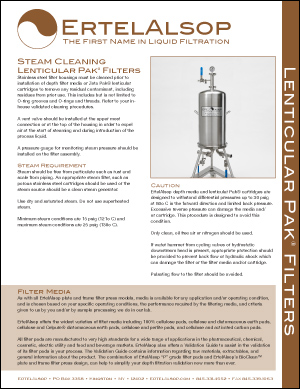Please read the following instructions in their entirety prior to performing the procedure.
Installation
Filter housings must be cleaned prior to installation of filter cartridges to remove any residual contaminant, including residues from prior use. This includes but is not limited to O-ring grooves and O-rings and threads. Refer to your in-house validated cleaning procedures.
A vent valve should be installed at the top of the housing in order to expel air at the start of steaming and during introduction of the process liquid.
A pressure gauge for monitoring steam pressure should be installed on the filter assembly.
Steam Requirement
Steam should be free from particulate such as rust and scale from piping. An appropriate steam filter, such as porous stainless steel cartridges should be used or the steam source should be a clean steam generator.
Use dry and saturated steam. Do not use superheated steam.
Minimum steam conditions are 15 psig (121o C) and maximum steam conditions are 25 psig (130o C).
Caution
ErtelAlsop Pak® lenticular filter module cartridges are designed to withstand differential pressures up to 30 psig at 80oC in the forward direction and limited back pressure. Excessive reverse pressure can damage the cartridge. This procedure is designed to avoid this condition.
Only clean, oil free air or nitrogen should be used.
If water hammer from cycling valves or hydrostatic downstream head are present, appropriate protection should be provided to prevent back flow or hydraulic shock which can damage the filter.
Pulsating flow to the filter should be avoided.
Steaming
This procedure is designed for in-line steaming of the Pak® lenticular filter module assembly. Contact ErtelAlsop for information about steam autoclaving the Pak® filter or filter assembly.

Refer to the diagram in Figure 1.
1. Air/nitrogen (D) and steam inlet valve (A) should be closed.
2. Close the inlet valve (B) and filter outlet valve (G).
3. Fully open the filter outlet valve (F).
4. Crack open valve (H) and the filter housing vent (E) and drain valves (I, J).
5. Open the steam inlet valve (A) and valve (C).
6. Fully close the filter housing vent (E) valve as soon as steam flow is apparent.
CAUTION: Valves will be hot and could cause injury if touched without appropriate protection.
Exposure to the steam flow from the vent valve (E) may cause injury. Direct the flow with appropriate tubing such that contact with personnel is avoided.
7. Steam flow through the filter assembly should proceed for 30 minutes or as long as experience dictates.
Monitor steam pressure via the pressure gauge on the filter housing making sure that pressure does not fall below 15 psig. A pressure gauge may be installed immediately downstream of the filter assembly to monitor differential pressure across the filter cartridge.
8. Close the steam inlet valve (A) and drain valve (H).
9. Close valve (C). In order to avoid excessive back pressure, clean oil free air or nitrogen may be introduced to the upstream side of the filter assembly when the steam pressure falls below 15 psig through air/nitrogen valve (D).
10. Air/nitrogen should be regulated to 15 psig. Open valve (D).
11. Immediately close valve (I) and drain valve (J).
12. Close air/nitrogen valve (D).
13. Allow the filter assembly to cool to ambient temperature.
This procedure is represented as being typical and is based on experience in our laboratories. It may not be representative of your specific physical arrangements or validated standard operating procedures. Please contact ErtelAlsop if you have any questions.

